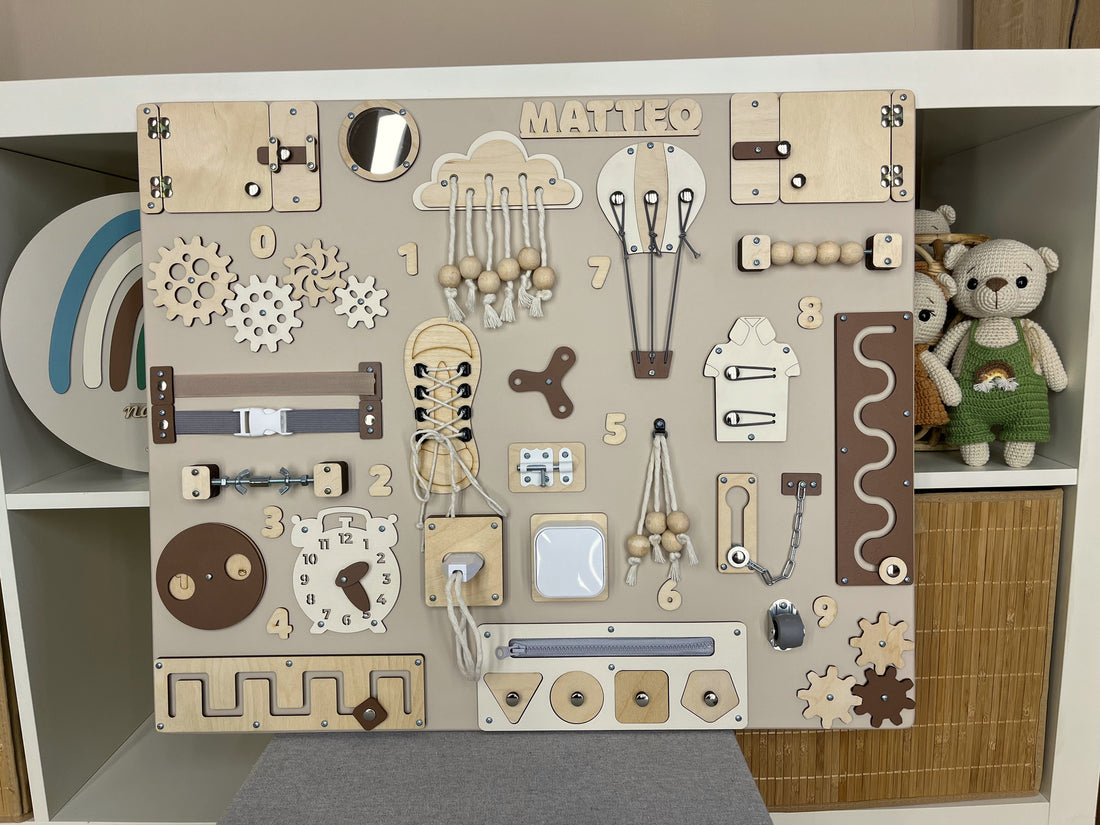
The Benefits of Busy Boards: Why Every Toddler and Baby Needs One
Share
Busy board for toddlers. What is it? What is it for? What are the benefits?
A busy board is an innovative sensory toy that encourages children to develop their motor and sensory skills. It is usually available as a board to hang on the wall. It can come in different sizes, large, medium or small for travelling. It features everyday items such as doorknobs, zips, locks, laced shoes, bells, wheels and many more. These items stimulate coordination and develop curiosity and a desire to experiment. With the activity board, the child gets a head start on development, with many benefits in the future.
What are the benefits of busy boards?
The busy board for babies are designed in accordance with the principles of Montessori science, which ensures that they stimulate a multitude of the child's senses. The toddler's learning through touch enables them to gain knowledge of the world around them in a creative and imaginative manner. The various elements of the boards encourage creativity, perceptiveness and logical thinking, which has a positive effect on the child's development in the present and in the future. Furthermore, playing with the activity boards brings joy to children and parents alike. The excitement of play supports the faster development of small motor skills and independence. Additionally, the boards provide children with the freedom to experiment and tinker, offering hours of enjoyment.
However, a developmental board does not only help children to master everyday life, its greatest benefit is that it:
- improve fine motor skills, train the muscles of the hands and fingers;
- promote faster speech development;
- teach kids to concentrate, improve memory;
- train logical thinking;
- broaden horizons, help to learn about the world around them;
- help to learn colours, geometric shapes, numbers;
- help to master laces, buttons and other items of clothing accessories;
- develop imagination and creative thinking.
According to psychologists, it is necessary to develop a baby in a playful way, so a busy board will perfectly cope with this task.
Maria Montessori and busy boards
The idea of such an educational toy is not new. The first sensory boards, similar to the modern busy board, were developed in the early 20th century. In Rome in 1907, Maria Montessori proposed to make a training stand with a variety of household items that a child should learn to use in everyday life but which they are often not allowed to play with because they are dangerous. Thus, playing with a switch, a socket, various fasteners, laces, and Velcro, children explored and tested all these items and got to know their intended purpose.
What should a toddler busy board contain?
This toy is supposed to make the toddler interested in it. Therefore, it is worth paying attention not only to the design, but above all to its usefulness and the possibilities it offers the child. A activity board for a one-year-old will be different from one for a preschooler, so when you decide to buy it or make it yourself, pay attention to the elements it contains. A toddler should not play with a board that has parts that can break off and be swallowed. Protruding strings must be short enough not to be twisted around the neck. No part can cause harm. So if your child's manipulative board contains buckles or snaps, check their pressure so that they do not cause pain.
An interesting option is a double-sided manipulative board, which will probably cost more but will also give your toddler double the fun. It's a good option with two children, even of different ages, to play together and discover new uses and properties of different objects. Regardless of the age and sex of the toddlers, such a toy must be free of sharp parts. Round or square pieces that resemble building blocks can be attached to it.
